Brafton recently turned 13. Thank you for the cards and birthday punches.
In that span of time, a lot has changed about Brafton, about content marketing and about consumer search behavior. And we’ve redesigned our website many times over to accommodate these evolutions.
Our blog in particular recently made it to year 13 – it launched April 1, 2010. Similar to our site redesigns, our blog has undergone its fair share of changes in terms of strategy, word count requirements, structural formatting and UX.
2010: Blog No. 1 Is Super Short, Newsy and CTA-less
Brafton’s inaugural blog post, titled “SEO ninjas infiltrate company website, actually make it more visible” was a brief four-paragraph rehash of a news story.
The only conceivable audience for this piece would be search bots, as the phrase “search engine optimization (SEO)” was used three times in ways that seemed a tad forced. Additionally, there are no outbound links, images, calls-to-action or analysis: just a few hundred words and a little bit of light humor.
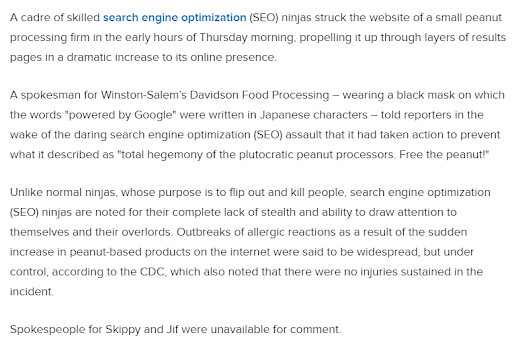
Yep, that’s the entire article.
In this era, we were publishing a new blog article about three to five times a day. That’s what SEO required at the time: volume, speed and high-level keyword matching.
A bit later in the year, we moved into more clickbaity style, cultural touchstones, writing about TV, social media and tech giants – through the lens of marketing. Here’s a sample:
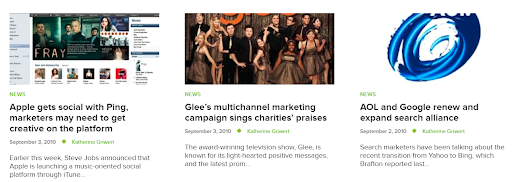
Outbound links and stock photography soon made their way into our blog.
2011: Expanding Our Topical Reach
In due time, our blog writing ventured into more relevant topics for our human readers, not just search engines. They also represented a shift in how we interacted with prospects and the market at large.
Trends articles, industry-specific studies and Google algorithm updates trickled into our blog rotation:
- Content marketing widely adopted by B2B software/computing companies
- Email marketing: Custom content required
- Matt Cutts says quality content is key to Google rankings (emphasis on quality)
We were still writing and publishing in bulk, but articles were now in the 300-word range, including in-line imagery, several external links and one or 2 internal links.
Additionally, the idea of “quality over quantity” hit the marketplace, and we represented that on our blog, a transition that continues to this day.
Subscribe to
The Content Marketer
Get weekly insights, advice and opinions about all things digital marketing.
Thank you for subscribing to The Content Marketer!
2012: Introducing a Li’l More Tech
As Obama’s second presidential campaign took off, the Brafton blog built upon its 2011 changes and introduced recurring industry news roundups, commentary on video and paid marketing — even our very own survey-based content.
The times were indeed a-changin’.
In general, blog articles grew slightly longer in length and there was a subtle shift in how we spoke to our target audience. Our service offerings were changing, too. Video and social media were now part of our product catalog. Content marketing was no longer exclusively defined by written copy; it was video, graphics, paid ads, data insights and social promotion.
In the survey, titled “Brafton’s content marketing poll results: Marketers find frequent, high-quality website content drives lead generation,” you can see the beginnings of long-form, user-generated content that addresses pain points and answers industry questions.
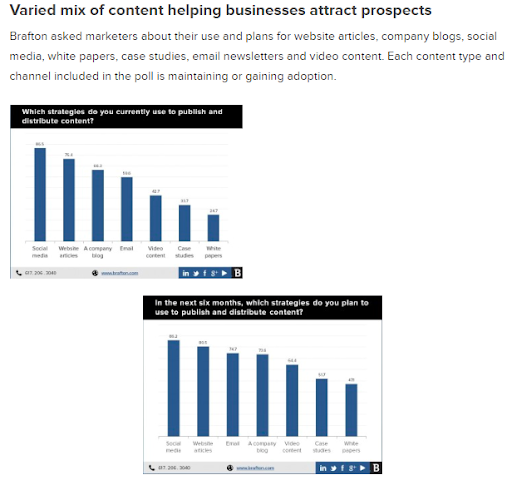
Embedded in this article were 6 custom graphs, 2 pull quotes and H2 subheads. Progress had materialized in a big way.
2013: Welcome Video Blogs, and Even More Studies
In 2013, our video blog product went mainstream for us and our clients. These short 1-2-minute videos turned regular news stories into easy-to-follow visual assets.
We often used video blogs to provide quick industry updates, and included the transcript beneath the video so that search crawlers could better index our pages.

You can also tell we were big into informing readers of the specific type of information they would consume before they clicked — as evidenced by the heavy usage of brackets in titles. Here are three examples all from the same day, April 23, 2013:

2014: More Events, More Internal Insights
Brafton ramped up its presence in the content marketing industry after attending a bevy of national events related to SEO, tech, lead gen and more.
We dove into publishing more employee features and other company-culture content. Here’s one of our firsts, a spotlight on Nick Kakolowski, one of our head writers. Nick was recognized for his long-form content prowess and his astounding record for never once receiving a client edit for an entire quarter in 2014.
You read that right. Nick’s copy was so pristine, clients had nothing to add.
2015: Fewer Posts, but Greater Content Diversity
As content marketers saw the light, and Google algorithms emphasized the point, volume was no longer the name of the game. Our client-facing strategies and our own blog publication schedule shifted gears for written content.
Our content grew longer, sometimes even cracking 800 words! Blog posts were published every other day, or every two days, rather than several every single day.
As an industry, we took a deep breath, took a step back and reassessed the marketing landscape. Like we said, though, a lot of this recalibration was forced upon marketers because Google was now prioritizing different ranking signals in its ever-evolving RankBrain algorithm. By this juncture, keyword-stuffing was penalized, thin content was pruned and black-hat SEOs were losing their grip — on the industry and their minds.
The Brafton blog became a one-stop repository for content types spanning:
- Best practices videos.
- Event coverage.
- Evergreen articles.
- Case studies.
- Writing tips.
- Resources targeted at certain verticals, like finance, lifestyle and tech.
For what it’s worth, 2015 saw the gif enter the Brafton blog lexicon:
2016: Multimedia Hits the Airwaves
We published less in 2016, maybe once or twice a week. The topics were representative of changing marketing channels. Podcasts, web design, social media distribution, HTTPS and augmented reality were now on the scene, and our writers were quick to adapt.
Our blog strategy expanded to incorporate additional multimedia elements like Twitter and Instagram embeds, custom memes and gifs, hi-res stock photography and branded videos.

Our linking strategy also was more intentional, with each story often linking out to five or more sources, on top of including several internal links. Lastly, we upped our CTA game – just a hair. We now had dedicated CTAs in each post, and, wait for it, there was bold font and targeted hyperlinks to form fills, too!

2017: The Professionalization of Data-led Research
In 2017, standard-bearers Jeff Baker and Lauren Fox took ownership of the Brafton blog. We wanted a blog that did more than generate traffic. We wanted a blog that drove sales conversations, fueled email marketing campaigns and dominated SERPs for high-value organic keywords.
And that’s what happened.
The topics we wrote on were dictated not by whim or general interest. They were all rooted in SERP data, competitive analysis and relevance to our commercial goals.
In practice, this translated to lots of lengthy, evergreen guides, how-tos and step-by-step instructionals. It also synced with our new approach to gated content, predominantly eBooks.
We dual-released eBooks as gated and ungated content so that we could generate leads (via form fill) and rank in SERPs. This strategy paid off handsomely; we got nearly five times as many pageviews to our eBooks in 2018 than we did in 2017.
Our blog was now firmly in the driver’s seat of our company-wide inbound sales model.
We dramatically curtailed our cold-calling, and relied, instead, on our blogs and email to do the heavy lifting. Soon, our sales team was receiving calls from prospects commending our work and requesting more assets.
We’d be remiss to mention that 2017 was also the year we pivoted to custom illustrations and a larger overhaul of our brand image. We killed stock photography and we were proud of it. We celebrated it with this post.

And here’s a snapshot of the types of blogs we were creating and the visuals that accompanied them:

From this point on, everything we produced was custom and user-focused.
2018: The Year of Re-optimization
By this point in our history, Brafton had generated nearly 10,000 blog posts, and they lived all over the internet. But it wasn’t always easy to tell whether content at that scale was worth it, especially if posts from 2010 were no longer relevant.
That’s why we undertook a massive movement toward re-optimizing older posts for a modern audience. We had good content, and it was easier to make it better, rather than writing everything from scratch like we had been doing for nearly a decade.

Some of our top re-ops were originally written in 2017 or earlier, like Financial content marketing that works: 5 ways the finance industry is winning at content. This post now ranks No. 1 for our target keyword “financial content marketing,” and it has stayed at the top of SERPs month after month.
Another huge win for our Brafton blog in 2018 was the standardization of our weekly news roundup under the name “Content Marketing Weekly.” We post these every Friday, and they help add timeliness and industry relevance to our email newsletters, too. You can find the entire series here.
2019: Expanding Into More Types of High-powered Content
Our blog became an integral part of our sales and lead gen process. It’s central to our social media and email marketing, and we use it to promote internal progress and new employees, too.
The volume of pageviews we’ve received to our site over the years has varied quite dramatically, some years spiking, others falling considerably. Seen below is the average monthly traffic our site generated by year. Because our blog page, specifically, has undergone technical and structural changes, tracking its individual metrics all the way back to 2010 isn’t possible, but sitewide traffic is a fair stand-in.

As our brand – and our blog – grew, so did our traffic. But in recent years, our internal commercial goals have moved away from raw traffic counts. We pivoted more toward thought leadership, and developed original perspectives on the future of content marketing.
The traffic we received was much more qualified, intent-driven and sales-ready. And that translated to more newsletter subscriptions, content downloads, email lists and prospects.
That’s a valuable takeaway.
Our blogs focused on research that our customers would find valuable in their own content creation journey. From headline advice to the number of resources to use in a blog, our perspective shifted entirely toward our customers.
By mid-2019, we attended MozCon, an SEO conference where we learned incredibly valuable insights from some of the leaders in the industry — lessons we applied right away and still use today.
We also got a bit reflective on our 10th blog anniversary. We’re dedicated to watching the years pass and learning from the leaders and lessons we’ve encountered along the way.
2020: Unprecedented Content That Resonates
This wasn’t anyone’s favorite year to date, but we tried to make the best of it.
While we were stuck indoors during the COVID-19 lockdowns, our remote teams continued to create interesting, engaging content… some of which was pretty on the nose to help our readers make it through as well.
Brafton was prepared to keep marketing strategies on the rails — here are some examples:
- Status check: What should marketers be doing as we start re-opening?
- 10 Content Marketing Ideas for the Coronavirus Lockdown
Despite these tough times, more people than ever were online, trying to grow, learn, read and expand. Because of this, we broke 1 million visitors to the blog for the first time.
2021 – For Our Skimmers Out There: Infographics
To make our content more attractive, and to pair our original images with something interesting, we did some research on infographics. By adding a few to select blogs, we learned that reader engagement shot through the roof: click-through rates went up an additional percent and generated 25% of all clicks on our blog pages.
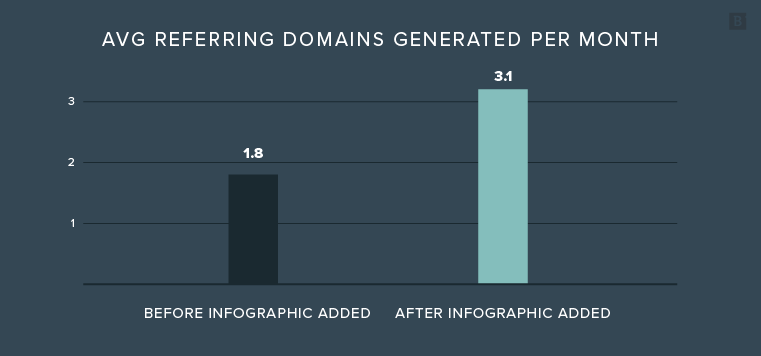
Not only are infographics an easy way for readers to gather information, but they can be repurposed on our Instagram and LinkedIn — offering more chances to reach more people.
2022 – Is This a Crossover Episode?
Who doesn’t love new friends? In 2022, we continued our relationship with SEO leader Moz and we even had the pleasure of writing some original content for their blog:
- Why It’s Getting Harder to Rank for Some Commercial Keywords (+ What You Can Do About It)
- 5 Things I Learned About E-A-T by Analyzing 647 Search Results
- Case Study: The ROI of Re-optimizing Content (Plus Bonus How-To)
Think of the excitement you feel when you see a star cameo on your favorite show. Not only does that episode get more views, but it’s exposure for the celebrity as well. It demonstrates their range as an actor, while showcasing the show’s reach in inviting them for an episode.
This type of win-win relationship is important for blogs and insights as well. The chance to reach across the internet aisle and share ideas is an effective way to engage readers on both sides, rather than just sourcing their research.
These expanded our reach & brought new people to the Brafton blog as well.
2023 – Doubling Down on Original Research
Performing your due diligence as a writer and researching topics you might not be familiar with or up to date on is essential. However, when you can conduct your own research and glean insights your readers will appreciate, that’s something else entirely.
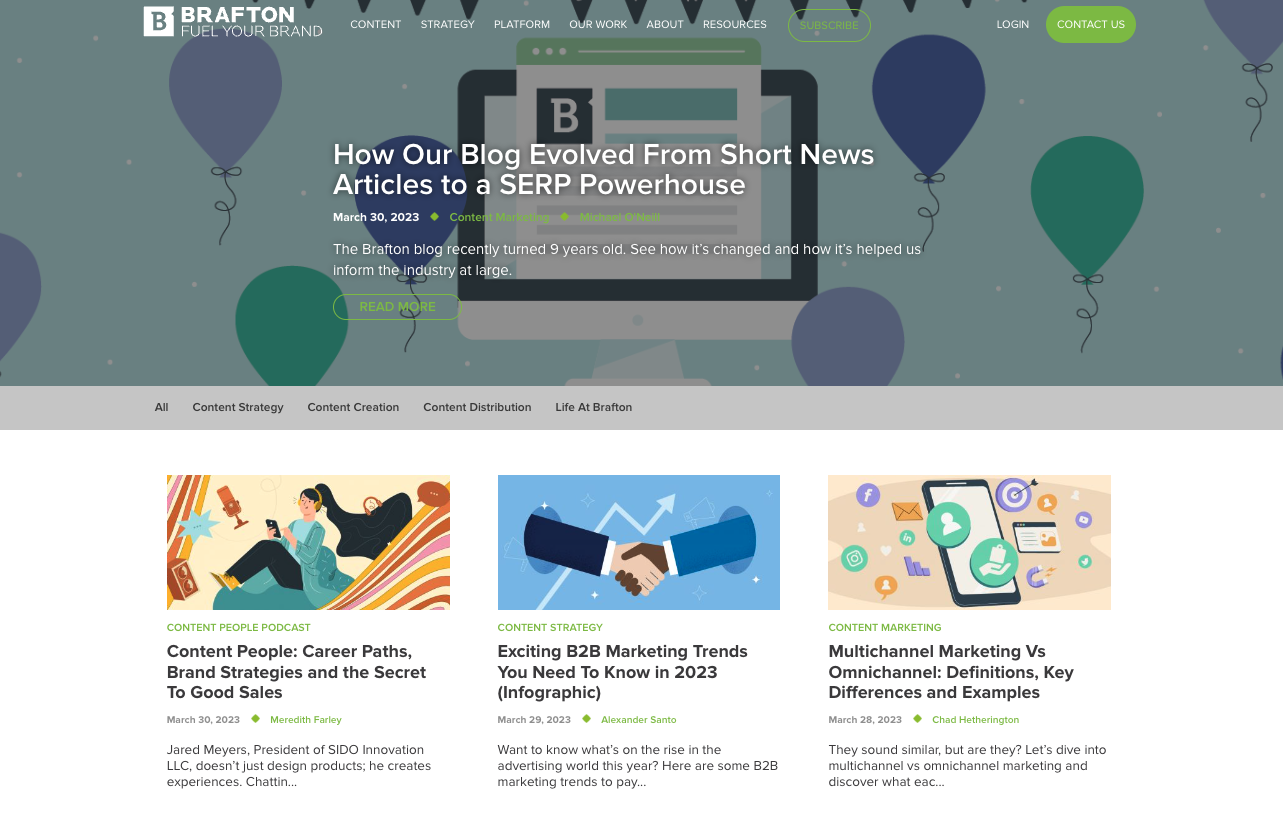
This year, we’re still continuing to double-down on what we know works, like infographics, guest blogging and high-value content. But we’re also making an effort to conduct our own research to learn more about our audience and the industry.
In response, we developed Brafton Labs to further expand what we know about content marketing. The surveys we’ve conducted give us the opportunity to better understand how marketers think:
- How Marketers Are Handling the Transition to Google Analytics 4
- 61% of B2B Marketers Are Using TikTok: Survey Results
- Mastering Content Marketing Management in 2023: Survey Results

It’s not about quantity, but quality – in your content, in your traffic and in your leads. At the end of the day, online marketing exists to generate new business, and our blog has come a long way toward accomplishing just that.
So that’s our marketing journey, what about yours?
Editor’s Note: Updated March 2023.





